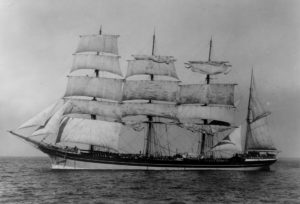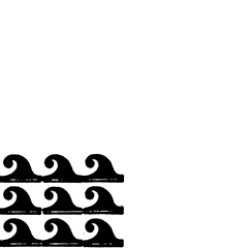Sea Shanties
Seafarers have probably sung songs ever since two people tried to row a boat together. For coordinating human activity, nothing beats a good shanty! And in fact, shanties as we know them today were developed aboard ship during the 1800s to coordinate sailors at work at heavy tasks, like hoisting yards up a mast, or heaving-up the anchor, or even pumping the ship dry!
During the period from about 1815 until the 1840s, shanties came into their own aboard transatlantic packet ships. These sailing packets carried general cargoes and passengers from American east coast ports (like New York, Boston, Philadelphia and Halifax) to Liverpool or London, England; and to various European seaports, including Antwerp, Le Havre, and Marseilles. They returned with European goods, and immigrants seeking a new life in America. Shanties were also used aboard the ships that brought cotton from Gulf of Mexico ports, like New Orleans and Mobile, to European industrial centers.
In the 1840s and ’50s, when the fabulous tea-clippers were built to race home with the season’s first cargoes of tea, shanties went off to China with their crews, and new songs were written about the “flying-fish sailors” who worked these ships.
As merchant sailing vessels grew ever larger (to accommodate bulk cargoes such as coal, grain and lumber), they were faced with competition from the “newfangled” steamships. Their owners were obliged to use fewer and fewer sailors to handle ever larger vessels, in order to make even a moderate profit. From about 1870 until the turn of the 20th Century the shanty became a necessary part of running a ship, since the vessels (and their sails) were much larger; and instead of a crew of 30 or 40, the owners operated them with 25 seamen or fewer.
No wonder the mariners of old used to say a shanty is “worth ten men on a rope”!

Sailors shake out the mizzen lower topgallant sail aboard the four-masted bark Dona Francisca (later Herbert). The photographer may have heard a shanty after he made this exposure, as the main and mizzen upper t’gallant yards were hoisted to make room to set the topmost sails.
So, what are shanties? Basically they are simple, memorable
songs that provide the proper rhythm for a particular job, and include a
time for sailors to work, and a time to rest. They were led by the
“shantyman,” whose role was honorary: he was selected from among the
crew by popular consent. The most famous shanty of all, and justly so,
was Blow the Man Down:
“As I was a’rollin’ down Paradise Street
To me, way, hey, blow the man down!
A handsome flash packet I chanced for to meet
Ooh! Give me some time to blow the man down!”
It was used for hauling (pulling) on all kinds of lines (ropes). When the shantyman began to sing, the “crowd” would eagerly anticipate the story while waiting for the moment to haul away. When the singer came to “Way, hey, blow the man down!” the crowd would sing as they pulled twice on the rope; that is, on the words “hey” and “down.” They would all pull again on “time” and “down.” The shantyman would continue the story, and the crowd would continue singing and hauling, until the mate or bosun brought everything to a stop by shouting “Well enough!” or “Belay!” (which means “stop what you’re doing”).
Different shanties evolved for different tasks: a slow march was needed to “tramp around the capstan,” the axle-like device that brings up the anchor chain. But a jiggety-jig rhythm was needed at pumps, many of which had a “teeter-totter” handle much like the teeter-totter in a playground: one handle would rise when the other was pushed down, and so by pushing down the opposing sides in turn, the pump operated.
Lyrics of shanties and sea-ballads were first collected as folk-poetry in the mid-1800s; beginning about 1900 sheet-music began to be published, and an effort was made to preserve the ways in which these songs were used. Shanties still common among us include What’ll We Do with the Drunken Sailor, Donkey Riding, Shenandoah, and Haul Away, Joe. But there are perhaps 250 to 300 traditional shanties available, thanks to dedicated folklorists, musicologists, and the sailors themselves.
Sea Shanties: A Basic Bibliography
Many of these books have been published in several editions; most are now out-of-print, but worth looking for.
Bone, David W. Capstan Bars. New York: Harcourt, Brace and Company.
Colcord, Joanna C. Songs of American Sailormen. New York: W.W. Norton & Com-
pany. Enlarged and revised ed. of Roll & Go: Songs of American Sailormen.
Doerflinger, William Main. Songs of the Sailor and Lumberman. New York: The
Macmillan Company; London: Collier-Macmillan Ltd. Second ed. of Shantymen
and Shantyboys.
Harlow, Frederick Pease. Chanteying Aboard American Ships. Barre, VT: Barre Gazette.
Hugill, Stan. Shanties and Sailors’ Songs. New York: Praeger Publishers.
Hugill, Stan. Shanties from the Seven Seas: Shipboard Work-songs and Songs Used as
Work-songs from the Great Days of Sail. London: Routledge & Kegan Paul; New
York: E.P. Dutton & Company.
Huntington, Gale. Songs the Whalemen Sang. Barre, VT: Barre Publishers.
Palmer, Roy. The Oxford Book of Sea Songs. Oxford and New York: Oxford University
Press.
Shay, Frank. Iron Men and Wooden Ships: Deep Sea Shanties. Garden City: Doubleday,
Page & Company.
Whall, W.B. Sea Songs and Shanties. Glasgow: Brown, Son & Ferguson, Ltd.
Also Recommended:
Frank, Stuart M. Jolly Sailors Bold: Ballads and Songs of the American Sailor
(East Windsor, NJ: Camsco Music).
Harlow, Frederick Pease. The Making of a Sailor, or Sea Life aboard a Yankee Square-rigger.
Salem, MA: Marine Research Society.
Hugill, Stan. Sailortown.
London: Routledge & Kegan Paul; New York: E.P. Dutton & Company.
Warner, Anne. Traditional American Folk Songs from the Anne & Frank Warner Collection.
Syracuse: Syracuse University Press.
